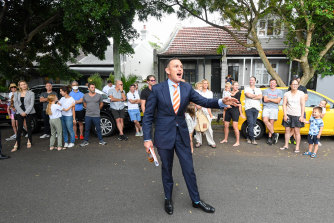Key points
- In a normal property market, the auction clearance rate is about 60 per cent, there is a healthy amount of homes for sale, and one buyer for each seller.
- The property market has eased since the recent boom in which several bidders often competed at auction for one home.
- As interest rates rise, buyers will be able to borrow less money, which could put downward pressure on property prices.
Property listings
The property market has weakened since last autumn’s boom, but with plenty of competition around for the most outstanding homes, agents say it has turned into a more normal market.
So what is a normal market?
What is a normal real estate market?Credit:Peter Rae
Steady auction clearance rates around the 60 per cent mark are one indicator, agents say, as the weeks of 80 per cent-plus clearance rates recorded a year ago are unsustainable over a longer period.
Healthy levels of homes for sale are another factor, alongside having a clear run of weeks to open a home for inspection without the interruption of lockdowns.
Another indicator is when there is one buyer for every seller, so the market is evenly matched – even if homes pass in on the auction floor and take longer to sell than in the days when a dozen bidders turn up on a Saturday morning and fought it out.
Century 21 chairman Charles Tarbey said the largest capital cities have already entered a normal market, although some regional areas and smaller cities such as Brisbane and Adelaide are not there yet.
The property market outlook is cloudy.Credit:Peter Rae
He said home buyers’ borrowing capacity was decreasing as interest rates began to rise, meaning hopeful sellers might need to meet buyers in the middle.
“We are coming into a marketplace where buyers and sellers can negotiate,” Tarbey said.
“You’ve got buyers who’d like to buy and sellers who want to sell, but what we had before was buyers who wanted to buy and hardly anybody who wanted to sell.
“A normal real estate market is where a buyer and seller get a chance to negotiate a position, whereas the market we’ve had, only the seller had a chance.”
He said an auction clearance rate of between 55 and 65 per cent made a normal market, which does not mean a property does not sell, only that it may take a week or more after auction for agreement on a deal.
Both Sydney and Melbourne auction clearance rates have hovered around the 60 per cent mark in May. Analysts correlate a 70 per cent auction clearance rate with annual property price growth of about 10 per cent but consider 60 per cent a balanced market.
In Melbourne, Barry Plant executive director Mike McCarthy agreed that the city was heading into a normal market, adding that inner and middle suburbs were already there while some outer suburbs were still at the tail end of a strong market.
In terms of days on the market, it would normally take about 30 days for a home to sell, but in strong markets properties are snapped up more quickly.
Homes are not snapped up as quickly when there is a better balance in the numbers of sellers and buyers.Credit:Meredith O’Shea
He said buyers were looking but not pushing as hard, citing auction results he had seen in his neighbourhood.
“I’ve seen a lot of pass-ins, but by the end of the day you’re seeing a sold sign on them, or you’re seeing a sold sign on the Monday or the Tuesday,” he said.
“That’s classic moving back into equilibrium – a bit more balance at the auction.”
He said buyers were quick to adjust once they saw other properties passing in, and may not bid as strongly, meaning sellers needed to look at very recent results to work out where their home sat rather than relying on nearby sales from late last year that may no longer be achievable.
The Agency chief executive of real estate Matt Lahood said a normal property market was one where there was a buyer for each seller, rather than numerous buyers willing to overextend themselves to win the competition for a property.
“This thing about having 10 people register and the first bid hitting the reserve that we’d been seeing, we all knew that was unusual,” he said.
“People potentially may be re-rated with their buying power as the interest rates continue to rise. They might have a loan application for $1 million today [and] in another [period of time] that $1 million becomes $900,000.”
He said the Sydney and Melbourne property markets have come back, but there were still slightly more buyers than sellers now, although a clearer picture could emerge through winter.
“Sellers need to know that if the interest rates continue to go up, their buyers … just won’t have the same buying power.” Lahood added that, on the other hand, buyers who don’t buy now could face reduced borrowing capacity.
Wakelin Property Advisory director Jarrod McCabe said a normal market can also mean one where sellers have a chance to open their homes for inspection over a month without the interruptions of the last two years’ lockdowns.
Instead, home sellers are thinking about seasonal characteristics such as selling a bayside property during the warmer months, he said.
He added that an increase in the number of homes listed for sale, with several auction weekends this autumn above 1000 auctions for Melbourne, had helped the market to balance out and reduced buyers’ fear of missing out.
“From a vendor’s perspective, you’ve got to be attractive in the marketplace,” he said.
“From a buyer’s point of view, I’ve seen plenty of auctions this year where there’s still been good levels of competition and strong prices being achieved, typically better properties that don’t have significant compromises … you still need to expect to have to compete for that.”
Most Viewed in Property
Source: Read Full Article



